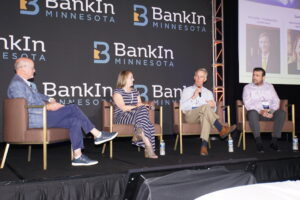Community banks are increasingly partnering with fintechs to offer new products or to improve the delivery of existing products. Three bankers who are forging new relationships with providers of fresh technology shared their experiences during the opening session of the annual convention of BankIn Minnesota, the trade group that changed its name a year ago from the Independent Community Bankers of Minnesota. The panel discussion took place on Aug. 1 in Eagan, Minn.

Anita Drentlaw, President/CEO, New Market Bank, Elko-New Market, Minn.; Jerry Reiter, President/CEO, Granite Bank, Cold Spring, Minn., and Bill LaVigne, Chief Operating Officer, The Bank of Elk River, Minn., concurred that while most of their recent partnership efforts grew out of experience related to providing PPP loans, everything is driven by a strategic plan.
“We focus innovation around our strategic plan,” said LaVigne, responding to a question posed by moderator Charlies Potts, executive vice president and chief innovation officer for the Independent Community Bankers of America. “If your thinking is, ‘we have to find a fintech partner,’ you are going to be overwhelmed. You are not going to know where to start.
“We became very disciplined about identifying what our pain points are, and really staying focused on finding solutions to solve this one problem,” LaVigne said. “We don’t overwhelm ourselves with too long of a checklist because you will just drown researching all these vendors.”
Drentlaw said she invites staff who will be involved in using the technology to help select the best tech solutions for the bank. “It is super important for buy-in to have the team members who are going to be implementing it helping to make that decision,” Drentlaw said. “And really driving the research, and figuring out which solution meets their needs the best. That has been key. Then when they are implementing it, they don’t complain because they decided it.”
Reiter explained that his bank’s strategic plan focused on capturing the generational wealth that was moving from baby boomers to millennials. “A couple people on our board said millennials don’t want to come into the bank. They don’t want to go through the hell of opening an account at our bank. I was offended. But then they pointed out to me that anyone can open an account at Bank of America on their phone in less than five minutes.”
Reiter explained the process of working with their core provider, then a fintech, and finally a programmer to create a custom solution for account opening. The bank tested it with a group of family and friends, and ultimately rolled it out.
Each of the bankers said their experience providing PPP loans affected their thinking on working with fintechs.
“During the first phase of PPP we did $25 million, exhausting 15 to 16 staff members working 80 hours a week. We said this has got to change,” Reiter said. “Second phase, we partnered with a fintech that also partnered with our core, and we did more than $25 million, and we used only two employees to do that. In addition, we put tutorials out, we did blogs. That expanded our footprint so now we have a pocket of customers in central Texas, and we have some in Florida. On the heels of that, we formed a tech committee that meets quarterly as part of our board of directors. We really got buy-in from the board on down.”
“We didn’t go out and find a vendor to make that happen,” LaVigne said regarding the bank’s program to process PPP loans. “We tapped the resources and the creative brains that work for us to put together a solution. We turned it up really quickly. I think it was a testament to leaning into the intelligence, and the problem-solving and the thinking of our people. You don’t always need to buy a solution. Sometimes you just need to create one.”
Drentlaw said her bank ramped up its processes to participate in the first phase of PPP lending, and partnered with a company called Teslar Software for the second phase. “We did more loans than we normally would do in three years in three months, all while being remote,” Drentlaw explained. “We just kind of figured it out as a team. On top of that, we opened a ton of new accounts. Fifty percent of those loans were new customers to the bank. The front line of our staff was amazing, going out to the customers’ cars in the parking lot to sign papers and signature cards. Plus, the mortgage department at the same time was doing more loans than they ever had.”
Drentlaw said now that the bank is set up with a reliable loan processing software partner, its staff members are more able to focus on higher value-added services. The bank is now working with Teslar Software to improve processes related to deposit gathering.
LaVigne said bank managers need to change the way they think about vendor management if they expect to work with a fintech. He said most fintechs are not going to be able to provide 10 references.
“The mindset that we had to overcome was in management and leadership that may have been uncomfortable with the fact that we were proposing to take someone new to the party, who didn’t have the credentials,” LaVigne explained. “Frankly, we were just very transparent from the beginning. I went to the board, talked at our executive meetings about the fact that this is a new company, and we recommend that we take the risk to do it because they are going to solve our problems, and we need to get over the fact that they don’t have the credentials and the reputation yet, but this is the world we are in. Let’s be bold and let’s jump in.”
